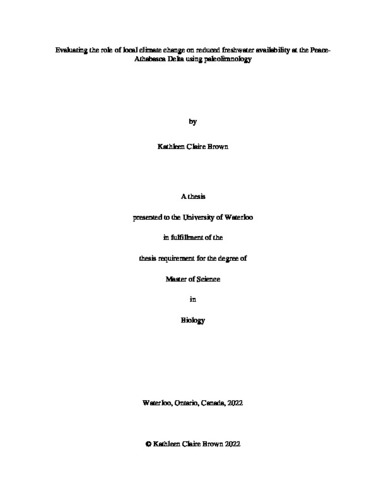| dc.description.abstract | Abundant small, shallow lakes across northern freshwater landscapes are particularly sensitive to alteration of hydrological processes, which makes them vulnerable to multiple potential stressors. At the Peace-Athabasca Delta (PAD; Treaty 8; northeastern Alberta), a Ramsar Wetland of International Importance, lake drying and associated ecological consequences present a critical water security concern due to potential stressors such as climate change and upstream industrial projects. Hydrometric, paleolimnological, and other studies have identified multiple mechanisms that have contributed to lake drying to varying degrees during the past century including upstream river regulation, climate driven changes in flood frequency and magnitude, geomorphic change in distributary flow, and contraction of Lake Athabasca from low lying areas of the PAD. The many mechanisms at play within the delta have made it challenging to distinguish the relative role of local hydroclimatic processes and conditions (i.e., catchment runoff, precipitation, evaporation, relative humidity) on lake drying at the PAD. This study focuses on identifying intervals when local hydroclimate has increased evaporation of lakes during the past ~400 years using paleolimnological analysis at four hydrologically isolated lakes adjacent to the PAD. Then, to determine the relative role of local hydroclimate in lake drying at the PAD, paleohydrological records from the study lakes were compared to paleohydrological data and contemporary hydrological monitoring records from perched basins within the PAD that exhibit recent drying. Specific intervals of interest include previously identified episodes of drying in the PAD during the Little Ice Age (LIA; 1600-1900 CE) and during the twentieth (1900-2000 CE) and twenty-first (2000-2019 CE) centuries. Lake water oxygen isotope composition was reconstructed from cellulose oxygen isotope composition (cellulose-inferred ẟ18Olw). Stratigraphic intervals of cellulose-inferred ẟ18Olw values > 1 standard deviation above the lake-specific long-term mean were considered intervals more strongly influenced by evaporation. These ‘intervals of 18O enrichment’ were identified at two or more study lakes during the early LIA, late LIA, and since ca. 1995 and correspond to reconstructions of low relative humidity from tree ring records. Results identify that local hydroclimate contributed, in part, to lake drying in the PAD during the early LIA but was offset by increased influence of river floodwaters during the late LIA. During the twentieth century, local hydroclimate appears to have played little to no role in drying trends at lakes in the PAD, whereas a significant trend in cellulose-inferred ẟ18Olw values at one study lake during the past two decades suggests local hydroclimate may have contributed marginally to very recent lake drying trends. Importantly, twentieth century PAD lake drying does not appear to be influenced markedly by local hydroclimate; rather, increased evaporation at PAD lakes has been driven primarily by reduced frequency and magnitude of flooding. This research informs ongoing policy and conservation decisions by discerning the influence of local hydroclimate on lake-level drawdown within the PAD. | en |

